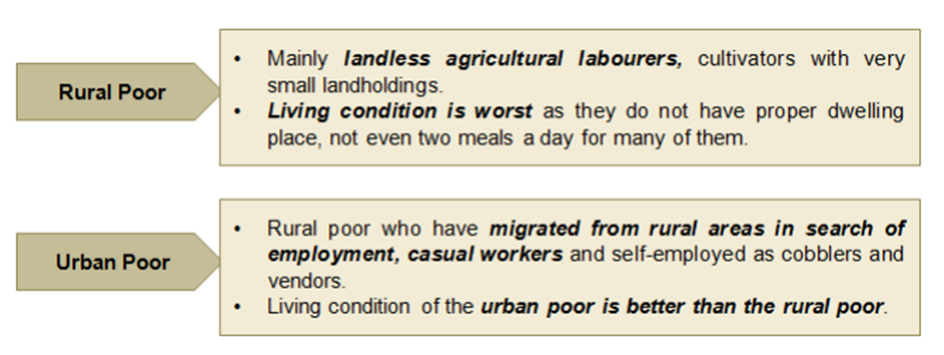Types of Poverty

Poor in Urban and Rural Areas:
- In Urban Areas, poor people include pushcart vendors, street cobblers, rag pickers, beggars, etc.
- They possess few assets.
- They reside in kutcha hutments with walls made of baked mud and roofs made of grass, thatch, bamboo and wood.
- The poorest of them do not even have such dwellings.
- The urban poor is largely the overflow of the rural poor who had migrated to urban areas in search of alternative employment and livelihood.
- In Rural Areas, poor people include landless agricultural labourers, cultivators with very small landholdings, landless labourers engaged in a variety of non-agricultural jobs or tenant cultivators with small land holdings.
- Many of the rural people are landless. Even if some of them possess land, it is only dry or wasteland.
- Many rural people do not get to have even two meals a day.
MEASURES OF POVERTY
There are two measures to determine the extent of poverty:
- Relative Poverty
- Absolute Poverty
Relative poverty refers to poverty of people, in comparison to other people, regions or nations. For example, If Ram has a lower income in comparison to Sham, and then we can say that Ram is relatively poor. It helps in understanding the relative position of different segments of the population. It only reflects the relative position of different segments of the population in the income hierarchy. It does not consider, how poor the person is or whether he is deprived of the basic minimum requirements of life or not.
Absolute Poverty refers to the total number of people living below poverty line. According to absolute measures, around 22% of India's population is below the poverty line. The concept of absolute poverty is relevant for the less developed countries like India, where there is abundance of poverty. It helps to measure the number of poor people. The method of "Poverty Line" used to measure absolute poverty does differentiate between the very poor and the other poor. Moreover, it does not consider social factors that generate and are responsible for poverty, illiteracy, ill-health, lack of access to resources, discrimination, or lack of civil and political freedoms.
Measurement of Poverty: Pre and Post Independent India
- In the Pre-independent India, DadabhaiNaoroji was the first person to discuss the concept of Poverty Line. He used the 'Jail Cost of Living' to calculate the poverty line.
- He used the menu for a prisoner and used appropriate prevailing prices, to arrive at the cost of consumption of an adult prisoner.
- He termed this consumption cost as 'jail cost of living'. As only adults stay in jail, he divided the population into two parts:
- He assumed that one-third of total population consist of children. One-half of them (i.e. 1/2 of 1/3 - 1/6) consumed very little, while the other half (i.e. 1/2 of 1/3 = 1/6 consumed half of the adult diet.
- Two-third population consisted of adults and they consume full diet.
- Weighted Average of consumption of the three segments: The average poverty line comes out to be three-fourth of the adult jail cost of living.
- 1/6 x Nil Diet + 1/6 x Half-Diet + 2/3 x Full Diet = 1/6 x 0+ 1/6 x 1/2 + 2/3 x 1= ¾.

 PathSet Publications
PathSet Publications
